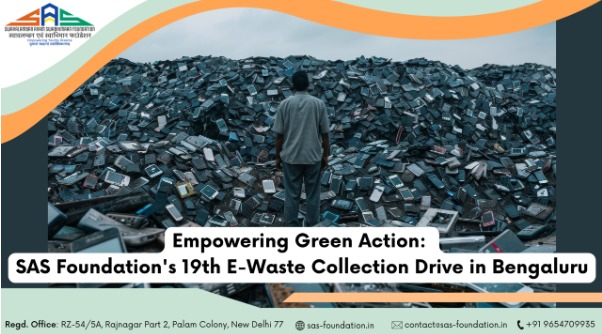♻️ Closing the Loop: How the Circular Economy Can Solve the E-Waste Crisis
In today’s hyper-connected world, the speed of technological advancement is nothing short of astonishing. From smartphones and laptops to wearables and smart home devices, we are more dependent on electronics than ever before. But this convenience comes at a cost: electronic waste (e-waste) is piling up at an alarming rate.
According to the Global E-Waste Monitor 2024, the world generated over 62 million tonnes of e-waste last year, and that figure is projected to continue rising. Shockingly, only 17% of it was formally collected and recycled. The rest? It either ends up in landfills, incinerators, or is handled by informal sectors — polluting soil, air, and water with toxic substances like mercury, lead, and cadmium.
Amid this environmental crisis, there’s a powerful concept offering hope: the circular economy. Unlike the traditional linear model of “take, make, dispose,” the circular economy envisions a closed-loop system where products are designed to last, and waste becomes a valuable resource.
At Swavalamban Avam Swabhimaan Foundation (SAS Foundation), we believe that embracing circular economy principles is not only essential but urgent. In this article, we explore how the circular economy can help us tackle the growing e-waste problem, and how individuals, industries, and policymakers can contribute to this much-needed transformation.
🔁 What Is the Circular Economy?
The circular economy is a model of production and consumption that emphasizes:
- Designing out waste and pollution
- Keeping products and materials in use
- Regenerating natural systems
When applied to e-waste, this means:
- Designing electronics that are durable, repairable, and upgradeable
- Encouraging reuse, refurbishment, and remanufacturing
- Creating efficient, safe recycling systems to recover valuable materials
The goal is to close the loop, where nothing becomes waste, and everything has a second (or third) life.
⚠️ The Urgency of the E-Waste Problem
Let’s consider the scale of the issue:
- India generated 1.6 million tonnes of e-waste in 2023 alone, making it the third-largest e-waste producer in the world.
- Less than 25% of India’s e-waste is formally collected and processed.
- Informal recycling often involves unsafe practices like burning wires for copper or acid-leaching components — harming both the environment and workers.
E-waste contains valuable metals such as gold, silver, platinum, and rare earth elements. But when improperly disposed of, these are lost forever, while the toxins contaminate communities.
🌱 Circular Strategies for E-Waste Management
1. Designing for Longevity
The first step toward a circular economy is rethinking how products are made. Manufacturers must:
- Use modular designs that allow parts to be easily replaced or upgraded
- Avoid gluing or welding components, making disassembly easier
- Prioritize durability over disposability
Right-to-repair policies are gaining traction globally, ensuring consumers can fix their devices rather than replace them.
2. Promoting Reuse and Refurbishment
Not every device that becomes “e-waste” is useless. Many can be refurbished and reused, especially in educational or rural settings.
SAS Foundation works with local partners to:
- Collect gently-used electronics
- Repair and clean devices
- Donate them to under-resourced communities
This not only diverts e-waste from landfills but also bridges the digital divide by giving others access to technology.
3. Recycling Programs That Work
When products reach end-of-life, safe and efficient recycling is critical. However, many existing systems are inefficient, fragmented, or informal.
A successful recycling program must:
- Partner with certified recyclers who meet environmental standards
- Provide drop-off centers and collection drives (like our 16-city e-waste campaign)
- Educate the public on what qualifies as e-waste and how to dispose of it
SAS Foundation has collected over 2.2 tonnes of e-waste in the past year alone — a testament to what community participation can achieve.
4. Extended Producer Responsibility (EPR)
EPR is a policy approach where manufacturers are held accountable for the lifecycle of their products, including end-of-life disposal.
In India, the E-Waste (Management) Rules mandate that producers must:
- Set up collection centers or take-back programs
- Partner with authorized recyclers
- Meet annual collection targets
When properly implemented, EPR can incentivize better design, reduce environmental damage, and shift the financial burden away from public agencies and informal workers.
5. Collaboration Across Sectors
The circular economy requires multi-stakeholder collaboration. NGOs, corporates, governments, and citizens must work together to:
- Build awareness and change behavior
- Co-create scalable waste management solutions
- Ensure fair compensation and protection for informal waste workers
- Integrate sustainability into CSR and ESG frameworks
At SAS Foundation, our partnerships with entities like Attero and residential societies demonstrate the potential of grassroots collaboration in driving large-scale impact.
🧑🤝🧑 How You Can Contribute
Change doesn’t require big budgets or revolutionary tech. Small, conscious actions add up:
✅ Buy responsibly: Choose products from brands that use recycled materials or offer repair services
✅ Maintain your electronics: Clean, protect, and update devices to extend lifespan
✅ Donate working electronics to NGOs or educational programs
✅ Recycle responsibly: Use certified e-waste recycling centers or join collection drives
✅ Spread awareness: Educate your family, friends, and workplace about the importance of proper e-waste disposal
📈 Looking Ahead: SAS Foundation’s Vision
As part of our environmental initiatives, SAS Foundation is committed to:
- Expanding e-waste drives to 10+ Indian cities
- Launching awareness campaigns in schools and colleges
- Training youth ambassadors in circular economy concepts
- Collaborating with industry leaders for sustainable product innovation
Our goal is not just to collect e-waste — but to change the mindset around consumption, responsibility, and environmental stewardship.
🌍 Conclusion: A Future Within Reach
The e-waste crisis is real, but it’s not irreversible. The circular economy provides a clear, actionable path forward — one where we design smarter, use longer, and recycle better.
At SAS Foundation, we believe that every individual has a role to play in this transformation. By embracing circular thinking, we can protect the planet, conserve resources, and build a sustainable future for generations to come.
📩 Stay Informed. Stay Empowered.
🔗 Read more articles and subscribe to our newsletter for the latest updates on e-waste management, sustainability, and circular economy solutions.
Together, we can turn waste into opportunity — and hope into action. 🌟










